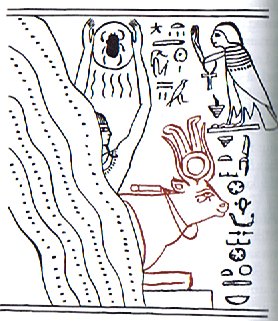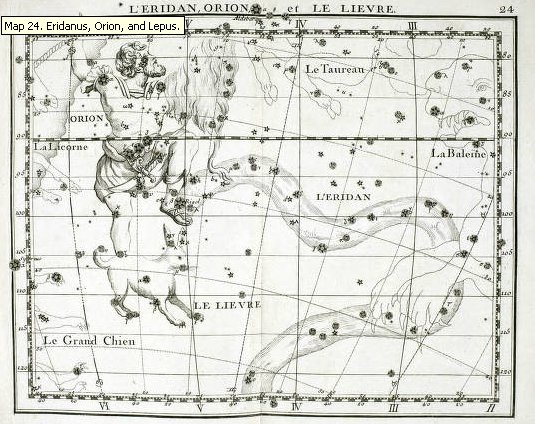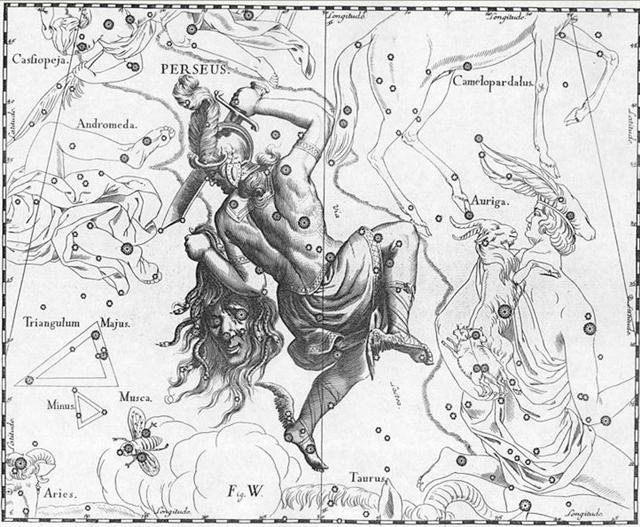154. Beyond Cb1-24 was the beginning of line
number 14 + 2 = 16 and its first glyph corresponded
to "April 1, where Metoro stated that (Mother Earth
as) Turtle (te honu) was flourishing (kua
tupu). At Cb12-24 Metoro saw rain (te ua)
and this ought reasonably to have led to such an effect on Mother
Earth:
 |
 |
 |
|
ko te rima |
kua oo ki te
vai |
ma te ua |
|
Cb1-22 |
Cb1-23 |
Cb1-24 |
|
CLOSE TO THE FULL MOON (and
nakshatra dates): |
|
*49 |
ALGENIB PERSEI
= α Persei
GIENAH (γ Corvi) |
*51 |
|
May 9 |
10 (130) |
11 |
|
şMay 5 |
6 |
7 |
|
'April 12 |
4-13 (→ 14 * 29½) |
14 (104 = 314 - 183 - 27) |
|
"March 29 (88) |
30 |
31 |
|
MARCH 6 |
7 (66 = 130 - 64) |
8 |
|
45 |
46 = 130 - 84 |
47 |

|
18 |
27 |
38 |
38 |
= 121 (= 11 * 11) |
The number of
'rain droplets' in the 4 'rivers
of time' above are here 121 as
in şMay 1 (Algol) or as in
Cb1-21 (Zuben Elschemali).
Hat-hor
(the House of Horus) emerged
after 11 * 11 dark nights. But
she could not be observed before
night number 121 + 16 = 137. In
ancient Egypt everything was
upside down and it was a Cow
instead of a Bull. But Bulls
cannot give birth. |
 |
 |
 |
|
Cb2-1 (392 + 25) |
Cb2-2 (418) |
Cb2-3 (27) |
|
Eaha te honu kua tupu |
i to
maitaki - o te hau
|
te hono
huki - maro |
|
CLOSE TO THE FULL MOON (and
nakshatra dates): |
|
*52 |
*53
ACRUX (α CRUCIS)
|
*54 |
|
May 12 (132) |
13 |
14 (500 = 134 + 366) |
|
"April 1 (91 = 7 * 13) |
2 |
3 (*13 = *54 - 41) |
|
MARCH 9 (68 = 132 - 64) |
10 |
11 (436 = 70 + 366) |
|
48 (= 68 - 20) |
49 (= *53 - 4) |
416 (= 500 - 84) |
|
Tupu
1. Shoot,
sprout, bud; to sprout, to
bud. 2. Pregnant: vî'e
tupu (o te poki); to be
conceived (of fetus in its
mother's womb): he-tupu
te poki i roto i te kopú o
toona matu'a. Vanaga.
To grow,
to sprout, to germinate, to
come forth, to conceive,
pregnant, germ; mea tupu,
plant; tupu ke avai,
of rapid growth; tupu
horahorau, precocious;
hakatupu, to produce,
to stimulate growth, to
excite. P Pau.: fakatupu,
to raise up, to create.
Mgv.: tupu, to grow,
to conceive, to be pregnant.
Mq.: tupu, to grow,
to sprout, to conceive. Ta.:
tupu, to grow, to
sprout. Churchill. Mgv.:
Tupu, the best or worst,
used of men or of bad
qualities. Sa.: tupu,
king. Ma.: tupu,
social position, dignity.
Churchill. |
Metoro repeated his te ua 4 days
later at
the ua type of glyph, which suggests there
could have been 3
days of different quality in
between, possibly corresponding to
those 3 days when only cold food was
served:
... In China, every year about the
beginning of April, certain
officials called Sz'hüen used
of old to go about the country armed
with wooden clappers. Their business
was to summon the people and command
them to put out every fire. This was
the beginning of the season called
Han-shih-tsieh, or 'eating of
cold food'. For three days all
household fires remained extinct as
a preparation for the solemn renewal
of the fire, which took place on the
fifth or sixth day after the winter
solstice [Sic!] ...
 |
 |
 |
 |
|
Cb2-4 (420 = 407 + 13) |
Cb2-5 (396 + 25) |
Cb2-6 (30) |
Cb2-7 |
|
te ua |
koia ra |
kua tuku
ki to mata - ki tona tukuga |
e kiore -
henua - pa rei |
|
CLOSE TO THE FULL MOON (and
nakshatra dates): |
|
Al Thurayya-27 /
Krittikā-3 /
Hairy Head-18
(Cockerel) |
MENKHIB = ζ Persei
(57.6)
PORRIMA (γ Virginis)
|
ZAURAK (The Boat)
=
γ Eridani
(58.9) |
|
TAU-ONO
(Six Stones) |
Temennu-3 (Foundation
Stone) |
|
ATIKS = ο Persei, RANA = δ
Eridani
(55.1),
CELAENO (16 Tauri), ELECTRA
(17), TAYGETA (19),
ν Persei (55.3),
MAIA (20), ASTEROPE (21),
MEROPE (23)
(55.6) |
ALCYONE
(56.1),
PLEIONE (28 Tauri),
ATLAS
(27)
(56.3) |
|
15 (135 + 365 = 500) |
May
16 (136) |
17 |
18 (*58) |
|
şMay 11 |
12 |
13 |
14 |
|
(473 =
108 + 365) |
19 |
'April 20 |
21 (111) |
|
"April
4 |
5 (501 - 41 = 460) |
6 (*16) |
7 |
|
MARCH 12 |
13 |
3-14 (73) |
15 |
|
417 (= 501 - 84) |
52 |
53 (= 73 - 20) |
54 (= *58 - 4) |
|
... They go inland at the
land. The child nursed and
tended grows up, is able to
go and play. Each day he now
goes off a bit further away,
moving some distance away
from the house, and then
returns to their house. So
it goes on and the child is
fully grown and goes to play
far away from the place
where they live. He goes
over to where some work is
being done by a father and
son. Likāvaka is the
name of the father - a
canoe-builder, while his son
is Kiukava.
Taetagaloa
goes right over there and
steps forward to the stern
of the canoe saying - his
words are these: 'The canoe
is crooked.'
(kalo ki ama).
Instantly Likāvaka is
enraged at the words of the
child. Likāvaka says:
'Who the hell are you to
come and tell me that the
canoe is crooked?'
Taetagaloa
replies: 'Come and stand
over here and see that the
canoe is crooked.'
Likāvaka goes over and
stands right at the place
Taetagaloa told him to
at the stern of the canoe.
Looking forward,
Taetagaloa is right, the
canoe is crooked. He slices
through all the lashings of
the canoe to straighten the
timbers. He realigns the
timbers. First he must again
position the supports, then
place the timbers correctly
in them, but Kuikava
the son of Likāvaka
goes over and stands upon
one support. His father
Likāvaka rushes right
over and strikes his son
Kuikava with his adze.
Thus Kuikava dies.
Taetagaloa
goes over at once and brings
the son of Likāvaka,
Kuikava, back to
life. Then he again aligns
the supports correctly and
helps Likāvaka in
building the canoe. Working
working it is finished
... |
|
... They all sat down and
rested [on the plain of
Oromanga], when suddenly
they saw that a turtle had
reached the shore and had
crawled up on the beach. He
[Ira] looked at it
and said, 'Hey, you! The
turtle has come on land!' He
said, 'Let's go! Let's go
back to the shore.' They all
went to pick up the turtle.
Ira was the first one
to try to lift the turtle -
but she didn't move. Then
Raparenga said, 'You do
not have the necessary
ability. Get out of my way
so that I can have a try!'
Raparenga stepped up
and tried to lift the turtle
- but Raparenga could
not move her. Now you spoke,
Kuukuu: 'You don't
have the necessary ability,
but I shall move this
turtle. Get out of my way!'
Kuukuu stepped up,
picked up the turtle, using
all his strength. After he
had lifted the turtle a
little bit, he pushed her up
farther. No sooner had he
pushed her up and lifted her
completely off the ground
when she struck Kuukuu
with one fin. She struck
downward and broke Kuukuu's
spine.The turtle got up,
went back into the (sea)
water, and swam away. All
the kinsmen spoke to you
(i.e. Kuukuu): 'Even
you did not prevail against
the turtle!'
They put the injured
Kuukuu on a stretcher
and carried him inland. They
prepared a soft bed for him
in the cave and let him rest
there. They stayed there,
rested, and lamented the
severely injured Kuukuu.
Kuukuu said, 'Promise
me, my friends, that you
will not abandon me!' They
all replied, 'We could never
abandon you!' They stayed
there twenty-seven days in
Oromanga. Everytime
Kuukuu asked, 'Where
are you, friends?' they
immediately replied in one
voice, 'Here we are!' They
all sat down and thought.
They had an idea and Ira
spoke, 'Hey, you! Bring the
round stones (from the
shore) and pile them into
six heaps of stones!' One of
the youths said to Ira,
'Why do we want heaps of
stone?' Ira replied,
'So that we can all ask the
stones to do something.'
They took (the material) for
the stone heaps (pipi
horeko) and piled up six
heaps of stone at the outer
edge of the cave. Then they
all said to the stone heaps,
'Whenever he calls, whenever
he calls for us, let your
voices rush (to him) instead
of the six (of us) (i.e.,
the six stone heaps are
supposed to be substitutes
for the youths). They all
drew back to profit (from
the deception) (? ki
honui) and listened. A
short while later, Kuukuu
called. As soon as he had
asked, 'Where are you?' the
voices of the stone heaps
replied, 'Here we are!' All
(the youths) said, 'Hey,
you! That was well done!'
... |
|
... The Mahabharata
insists on six as the
number of the Pleiades as
well as of the mothers of
Skanda and gives a very
broad and wild description
of the birth and the
installation of Kartikeya
'by the assembled gods ...
as their generalissimo',
which is shattering,
somehow, driving home how
little one understands as
yet. The least which can be
said, assuredly: Mars was
'installed' during a more or
less close conjunction of
all planets; in Mbh. 9.45
(p. 133) it is stressed that
the powerful gods assembled
'all poured water upon
Skanda, even as the gods
had poured water on the head
of Varuna, the lord
of waters, for investing him
with dominion'. And this
'investiture' took place at
the beginning of the
Krita Yuga, the Golden
Age
... |
 |
|
... Vainamoinen set about
building a boat, but when it
came to the prow and the
stern, he found he needed
three words in his rune that
he did not know, however he
sought for them. In vain he
looked on the heads of the
swallows, on the necks of
the swans, on the backs of
the geese, under the tongues
of the reindeer. He found a
number of words, but not
those he needed. Then he
thought of seeking them in
the realm of Death, Tuonela,
but in vain. He escaped back
to the world of the living
only thanks to his potent
magic. He was still missing
his three runes. He was then
told by a shepherd to search
in the mouth of Antero
Vipunen, the giant ogre. The
road, he was told, went over
swords and sharpened axes.
Ilmarinen made shoes, shirt
and gloves of iron for him,
but warned him that he would
find the great Vipunen dead.
Nevertheless, the hero went.
The giant lay underground,
and trees grew over his
head. Vainamoinen found his
way to the giant's
mouth, and planted his iron
staff in it. The giant awoke
and suddenly opened his huge
mouth. Vainamoinen slipped
into it and was swallowed.
As soon as he
reached the enormous
stomach, he thought of
getting out. He built
himself a raft and floated
on it up and down inside the
giant. The giant felt
tickled and told him in many
and no uncertain words where
he might go, but he did not
yield any runes. Then
Vainamoinen built a smithy
and began to hammer his iron
on an anvil, torturing the
entrails of Vipunen, who
howled out magic songs to
curse him away. But
Vainamoinen said, thank you,
he was very comfortable and
would not go unless he got
the secret words. Then
Vipunen at last unlocked the
treasure of his powerful
runes. Many days and nights
he sang, and the sun and the
moon and the waves of the
sea and the waterfalls stood
still to hear him.
Vainamoinen treasured them
all and finally agreed to
come out. Vipunen opened his
great jaws, and the hero
issued forth to go and build
his boat at last
...
 |
A pair of niu glyphs were
following the Boat (Zaurak, γ
Eridani), possibly because here the Sea Beast (Cetus) had put
up his paws on dry Land:
 |
 |
 |
|
Cb2-8 (32) |
Cb2-9 |
Cb2-10 (426) |
|
Niu |
moe te goe |
|
*59 |
*60 |
*61 |
|
şMay
15 |
16 (136) |
17 |
|
55 |
56 (= 136 - 80) |
57 |

Clearly, however, this pair of niu
were pointing back to the similar
pair at Algenib Persei 9 days
earlier. 424 - 9 = 50 + 365:
|












